Dynamic Simulation Model of Trans-Critical Carbon Dioxide Heat Pump Application for Boosting Low Temperature Distribution Networks in Dwellings
Abstract
1. Introduction
2. Methods
2.1. Description of the Case Study
2.2. Matlab Simulink Analysis
2.3. Mathematical modelling
2.4. Trans-Critical CO2 HP Energy Balance
2.4.1. Gas Cooler
2.4.2. Compressor
2.4.3. Evaporator
2.4.4. Internal Heat Exchanger
2.5. CHP and Boiler Models
2.6. Balance Equations
2.6.1. Electric Balance
2.6.2. Heat Balance
2.7. Network Heat Losses
3. Results and Discussion
- In the first case, due to the higher electricity demand, the PEC increases; the additional electric energy has to be purchased from the national grid. On the contrary, in the second case, when the Thermal load enhances, the PEC tends to shrink.
- When the building PTHR is higher the Renewable fraction fRES goes down almost linearly due to the fact that the overall required energy is larger; notwithstanding, the renewable electricity production remains constant and its fraction on final electricity consumption lessens accordingly.
- The PES tends to slightly increase as the building PTHR grows up, owing to the electricity excess reduction.
4. Conclusions
- The proposed hybrid system adoption leads to an overall First Law Efficiency equal to 0.84 instead of 0.55. The achievable renewable fraction is 27% while the primary energy saving corresponds to 37%, approximately. The large use of renewables (i.e., aerothermal and solar) allows to get a heating efficiency in terms of primary fossil energy higher than 2;
- The low temperature distribution network development contributes positively to the system efficiency due to the thermal losses and head losses reduction. Even if the water flow rate is high, owing to the HPs operating temperature difference which is limited to 5 °C, the electric consumption for water pumping is lower. Notwithstanding, the piping diameters are greater than those related to the traditional heating plant.
- The use of PV and CHP makes the electricity purchase affordable, despite a large amount of electricity excess is sold to the Grid by the Net metering option. When electric storage devices are applied, a better exploitation of renewable energy occurs, increasing the energy classification of buildings, according to the performance indicators changes;
- Even if the conversion efficiency for DHW production is low due to the CHP heat recovery efficiency, the CHP electric power output favours the final reduction in the hybrid system PEC;
- By comparing the hybrid system with storage device with the traditional one, is it possible to get a considerable primary fossil energy saving (−50% approximately). Therefore, higher efficiency has been registered when replacing the most common technologies with the new commercial ones and along with the heat sharing solutions and electric storage devices. The batteries bank integration allows to reduce the electricity purchase from the national grid affecting positively the PEC values;
- According to the sensitivity analysis, the building PTHR increases and the fRES decreases consistently. However, the primary fossil energy consumption is higher than the Figures shown in the first scenario, but the energy saving increases.
- In order to achieve NZEB qualification, CO2-HPs and hybrid systems adoption are viable solutions. Our next step would be to improve the hybrid system by taking CO2 potential at its peak. Furthermore, harmful refrigerants will be limited in the future, so it would be possible to use transcritical CO2 heat pumps.
Author Contributions
Funding
Acknowledgments
Conflicts of Interest
Nomenclature
| Cp | Specific heat (J/kg K) |
| D | Diameter (mm) |
| E | Energy (kWh) |
| G | Flow (l/h) |
| h | Enthalpy (kJ/kg) |
| Lh | Latent heat |
| Mass flow rate (kg/s) | |
| P | Pressure (bar) |
| Q | Heat load (kW) |
| r | Distributed load loss (mmH2O) |
| r | Density (kg/m3) |
| T | Temperature (°C) |
| v | Speed |
| W | Compressor work |
| x | Localized loss coefficient |
| η | Efficiency |
| λ | Thermal conductivity [W/m2K] |
| ν | Viscosity |
| Subscripts | |
| com | Compressor |
| des | Design |
| e | Electrical |
| ev | Evaporator |
| gc | Gas cooler |
| in | Inlet |
| is | Isentropic |
| out | Outlet |
| reg | Regeneration |
| sub | Sub cooling |
| t | Thermal |
| w | Water |
| Abbreviations | |
| CHP | Combined heat and power |
| CO2 | Carbon dioxide |
| COP | Coefficient of performance |
| DHW | Domestic hot water |
| fRES | Renewable energy fraction |
| GHG | Greenhouse gas |
| GWP | Global warming potential |
| HP | Heat pump |
| IHEX | Internal heat exchanger |
| nZEB | Nearly zero emission buildings |
| ODP | Ozone Depletion Potential |
| PEC | Primary energy consumption |
| PES | Primary energy saving |
| PTHR | Power to heat ratio |
| PV | Photovoltaic panels |
| RES | Renewable energy sources |
References
- EPBD. European Directive /31/UE on the Energy Performance of Buildings. 2010. Available online: http://eur-lex.europa.eu/legal-content/EN/ALL/ ?uri=CELEX:32010L0031 (accessed on 15 November 2018).
- Deng, S.; Wang, R.Z.; Dai, Y.J. How to evaluate performance of net zero energy building—A literature research. Energy 2014, 71, 1–16. [Google Scholar] [CrossRef]
- Braulio-Gonzalo, M.; Bovea, M.D. Environmental and cost performance of building’s envelope insulation materials to reduce energy demand: Thickness optimization. Energy Build. 2017, 150, 527–545. [Google Scholar] [CrossRef]
- Del Amo, A.; Martínez-Gracia, A.; Bayod-Rújula, A.A.; Antoñanzas, J. An innovative urban energy system constituted by a photovoltaic/ thermal hybrid solar installation: Design, simulation and monitoring. Appl. Energy 2017, 186, 140–151. [Google Scholar] [CrossRef]
- Dincer, I.; Acar, C. Smart energy systems for a sustainable future. Appl. Energy 2017, 194, 225–235. [Google Scholar] [CrossRef]
- Castellani, B.; Gambelli, A.M.; Morini, E.; Nastasi, B.; Presciutti, A.; Filipponi, M.; Nicolini, A.; Rossi, F. Experimental Investigation on CO2 Methanation Process for Solar Energy Storage Compared to COc-Based Methanol Synthesis. Energies 2017, 10, 855. [Google Scholar] [CrossRef]
- Noussan, M.; Nastasi, B. Data Analysis of Heating Systems for Buildings-A Tool for Energy Planning, Policies and Systems Simulation. Energies 2018, 11. [Google Scholar] [CrossRef]
- Rosa, F.; Carbonara, E. An analysis on technological plant retrofitting on the masonry behaviour structures of 19th century traditional historical buildings (THB) in Rome. Energy Procedia 2017, 133, 121–134. [Google Scholar] [CrossRef]
- Albo, A.; Rosa, F.; Tiberi, M.; Vivio, B. High-efficiency and low-environmental impact systems on a historical building in rome: An InWall solution. WIT Trans. Built Environ. 2014, 142, 529–540. [Google Scholar] [CrossRef]
- Groppi, D.; de Santoli, L.; Cumo, F.; Astiaso Garcia, D. A GIS-based model to assess buildings energy consumption and usable solar energy potential in urban areas. Sustain. Cities Soc. 2018, 40, 546–558. [Google Scholar] [CrossRef]
- Lo Basso, G.; Rosa, F.; Astiaso Garcia, D.; Cumo, F. Hybrid systems adoption for lowering historic buildings PFEC (primary fossil energy consumption)—A comparative energy analysis. Renew. Energy 2018, 117, 414–433. [Google Scholar] [CrossRef]
- Groppi, D.; Astiaso Garcia, D.; Lo Basso, G.; Cumo, F.; De Santoli, L. Analysing economic and environmental sustainability related to the use of battery and hydrogen energy storages for increasing the energy independence of small islands. Energy Convers. Manag. 2018, 177, 64–76. [Google Scholar] [CrossRef]
- Dominković, D.F.; Bačeković, I.; Sveinbjörnsson, D.; Pedersen, A.S.; Krajačić, G. On the way towards smart energy supply in cities: The impact of interconnecting geographically distributed district heating grids on the energy system. Energy 2017, 137, 941–960. [Google Scholar] [CrossRef]
- Dominković, D.F.; Bin Abdul Rashid, K.A.; Romagnoli, A.; Pedersen, A.S.; Leong, K.C.; Krajačić, G.; Duić, N. Potential of district cooling in hot and humid climates. Appl. Energy 2017, 208, 49–61. [Google Scholar] [CrossRef]
- Becchio, C.; Dabbene, P.; Fabrizio, E.; Monetti, V.; Filippi, M. Cost optimality assessment of a single family house: Building and technical systems solutions for the nZEB target. Energy Build. 2015, 90, 173–187. [Google Scholar] [CrossRef]
- Nastasi, B.; Di Matteo, U. Innovative use of Hydrogen in energy retrofitting of listed buildings. Energy Procedia 2017, 111, 435–441. [Google Scholar] [CrossRef]
- Bourrelle, J.S.; Andresen, I.; Gustavsen, A. Energy payback: An attributional and environmentally focused approach to energy balance in net zero energy buildings. Energy Build. 2013, 65, 84–92. [Google Scholar] [CrossRef]
- Zhao, Y.; Lu, Y.; Yan, C.; Wang, S. MPC-based optimal scheduling of grid-connected low energy buildings with thermal energy storages. Energy Build. 2015, 86, 415–426. [Google Scholar] [CrossRef]
- Mitra, S.; Sun, L.; Grossmann, I.E. Optimal scheduling of industrial combined heat and power plants under time-sensitive electricity prices. Energy 2013, 54, 194–211. [Google Scholar] [CrossRef]
- Al-Sharafi, A.; Yilbas, B.S.; Sahin, A.Z.; Ayar, T. Performance assessment of hybrid power generation systems: Economic and environmental impacts. Energy Convers. Manag. 2017, 132, 418–431. [Google Scholar] [CrossRef]
- Levihn, F. CHP and heat pumps to balance renewable power production: Lessons from the district heating network in Stockholm. Energy 2017, 137, 670–678. [Google Scholar] [CrossRef]
- Aprea, C.; Maiorino, A. An experimental evaluation of the transcritical CO2 refrigerator performances using an internal heat exchanger. Int. J. Refrig. 2008, 1006–1011. [Google Scholar] [CrossRef]
- Cabello, R.; Sanchez, D.; Llopis, R.; Torrella, E. Experimental evaluation of the energy efficiency of a CO2 refrigerating plant working in transcritical conditions. Appl. Therm. Eng. 2008, 1596–1604. [Google Scholar] [CrossRef]
- Cavallini, A.; Cecchinato, L.; Corradi, M.; Fornasieri, E.; Zilio, C. Two-stage transcritical carbon dioxide cycle optimisation: A theoretical and experimental analysis. Int. J. Refrig. 2008, 28, 1274–1283. [Google Scholar] [CrossRef]
- Cecchinato, L.; Corradi, M.; Fornasieri, E.; Zamboni, L. Carbon dioxide as refrigerant for tap water heat pumps: A comparison with the traditional solution. Int. J. Refrig. 2005, 28, 1250–1258. [Google Scholar] [CrossRef]
- Cho, H.; Lee, M.Y.; Kim, Y. Numerical evaluation on the performance of advanced CO2 cycles in the cooling mode operation. Appl. Therm. Eng. 2009, 29, 1485–1492. [Google Scholar] [CrossRef]
- Kauf, F. Determination of the optimum high pressure for transcritical CO2 refrigeration cycle. Int. J. Therm. Sci. 1999, 38, 325–330. [Google Scholar] [CrossRef]
- Kim, M.H.; Pettersen, J.; Bullard, C.W. Fundamental process and system design issues in CO2 vapor compression systems. Prog. Energy Combust. Sci. 2004, 30, 119–174. [Google Scholar] [CrossRef]
- Liao, S.M.; Zhao, T.S.; Jakobsen, A. A correlation of optimal heat rejection pressures in transcritical carbon dioxide cycles. Appl. Therm. Eng. 2000, 20, 831–841. [Google Scholar] [CrossRef]
- Wang, H.; Maa, Y.; Tian, T.; Li, M. Theoretical analysis and experimental research on transcritical CO2 two stage compression cycle with two gas coolers (TSCC + TG) and the cycle with intercooler (TSCC + IC). Energy Convers. Manag. 2011, 52, 2819–2828. [Google Scholar] [CrossRef]
- Kim, S.C.; Kim, M.S.; Hwang, I.C.; Lim, T.W. Heating performance enhancement of a CO2 heat pump system recovering stack exhaust thermal energy in fuel cell vehicles. Int. J. Refrig. 2007, 1215–1226. [Google Scholar] [CrossRef]
- Scoccia, R.; Toppi, T.; Aprile, M.; Motta, M. Absorption and compression heat pump systems for space heating and DHW in European buildings: Energy, environmental and economic analysis. J. Build. Eng. 2018, 16, 94–105. [Google Scholar] [CrossRef]
- Lan Yang, J.; Tai Ma, Y.; Li, M.X.; Hua, J. Modeling and simulating the transcritical CO2 heat pump system. Energy 2010, 35, 4812–4818. [Google Scholar] [CrossRef]
- Lund, H.; AlbergØstergaard, P.; VadMathiesen, B. Smart energy and smart energy systems. Energy 2010, 137, 556–565. [Google Scholar] [CrossRef]
- Sarkar, J.; Bhattacharyya, S.; Gopal, M.S. Natural refrigerant-based subcritical and transcritical cycles for high temperature heating. Int. J. Refrig. 2007, 30, 3–10. [Google Scholar] [CrossRef]
- Hepbasli, A.; Kalinci, Y. A review of heat pump water heating systems. Renew. Sustain. Energy Rev. 2009, 13, 1211–1229. [Google Scholar] [CrossRef]
- Xie, Y.; Wang, Z.; Cui, K.; Zhang, X. The Exergy Analysis of Gas Cooler In CO2 Heat Pump System. Procedia Environ. Sci. 2011, 11, 1555–1560. [Google Scholar] [CrossRef]
- CO2 As Refrigerant: The Transcritical Cycle. Available online: https://www.achrnews.com/articles/94092-co2-as-refrigerant-the-transcritical-cycle (accessed on 15 November 2018).
- Sarkar, J.; Bhattacharyya, S.; Gopal, M.R. Optimization of a transcritical CO2 heat pump cycle for simultaneous cooling and heating applications. Int. J. Refrig. 2004, 830–838. [Google Scholar] [CrossRef]
- Evoplus-B 120/220.32 M Product Specifications. Available online: https://www.dabpumps.com/it/evoplus-small (accessed on 15 November 2018).
- Oliveira Panão, M.J.N. The overall renewable energy fraction: An alternative performance indicator for evaluating Net Zero Energy Buildings. Energy Build. 2016, 127, 736–774. [Google Scholar] [CrossRef]
- Desideri, U.; Proietti, S.; Arcioni, L.; Leonardi, D.; Sdringola, P. Comparative analysis of three methodologies for the energy certification applied to residential buildings, developed in Italy in conformity with European directive EPBD 2002/91. In Proceedings of the ECOS 2007—Proceedings of the 20th International Conference on Efficiency, Cost, Optimization, Simulation and Environmental Impact of Energy Systems, Padua, Italy, 25–28 June 2007; p. 1495. [Google Scholar]

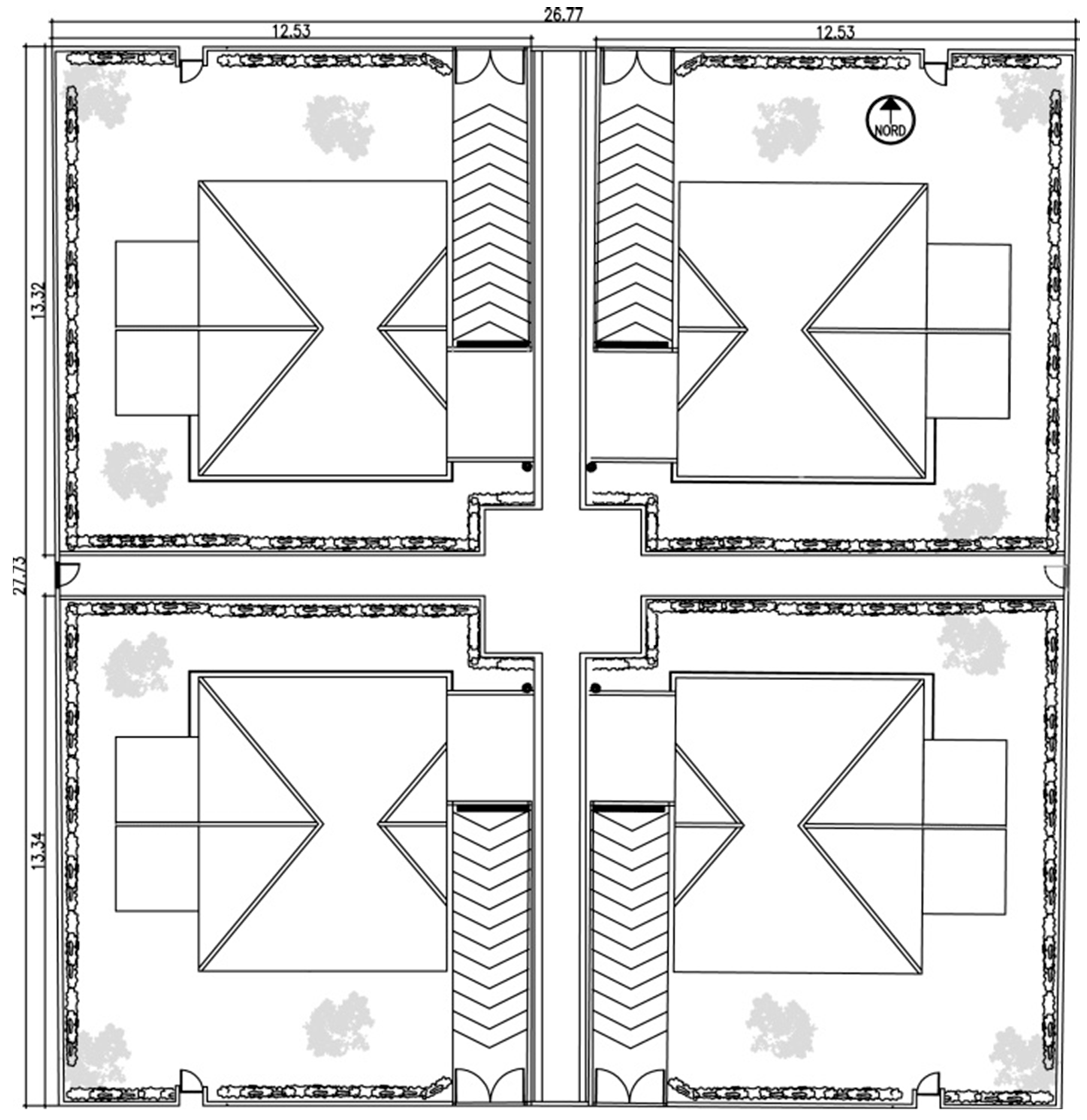


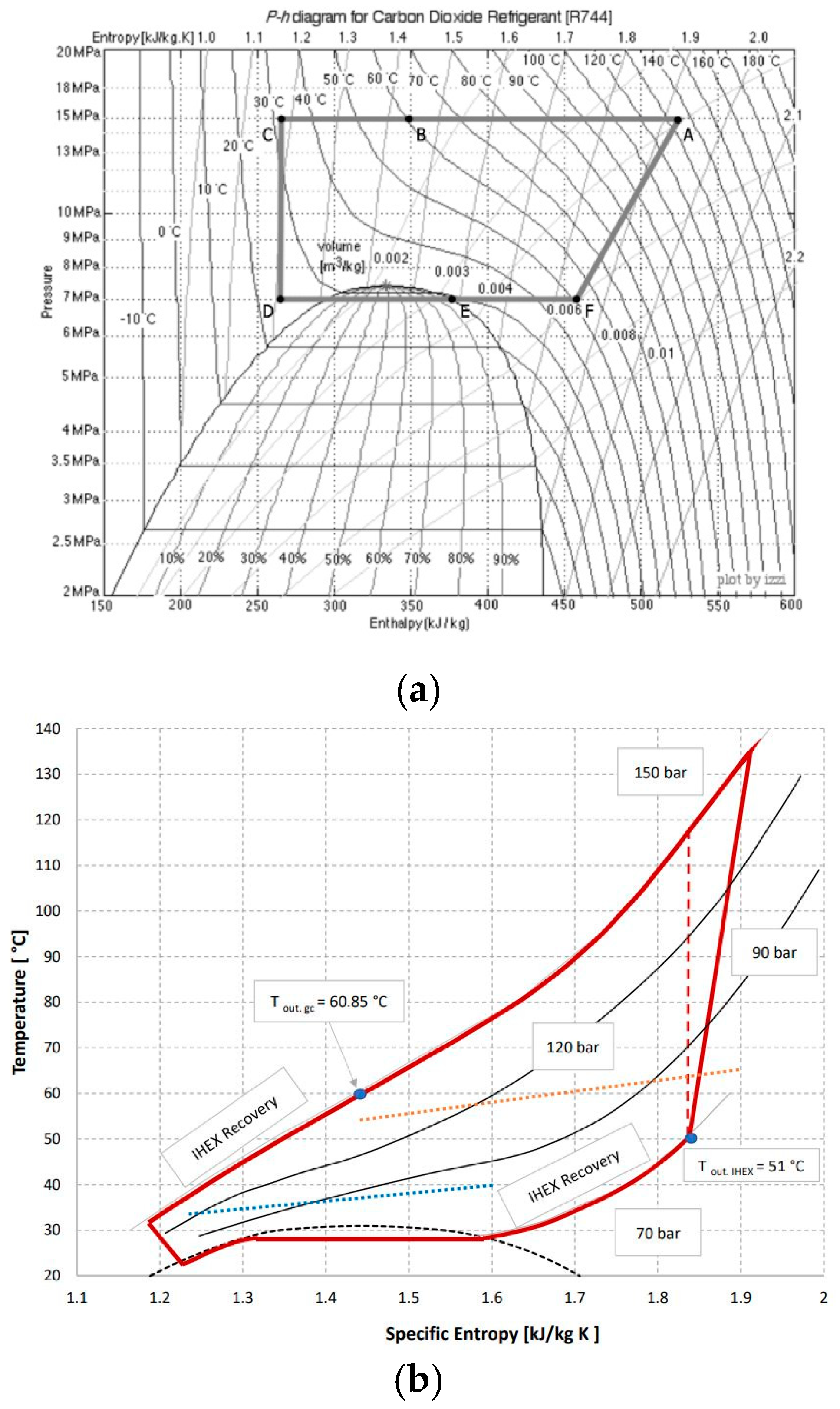
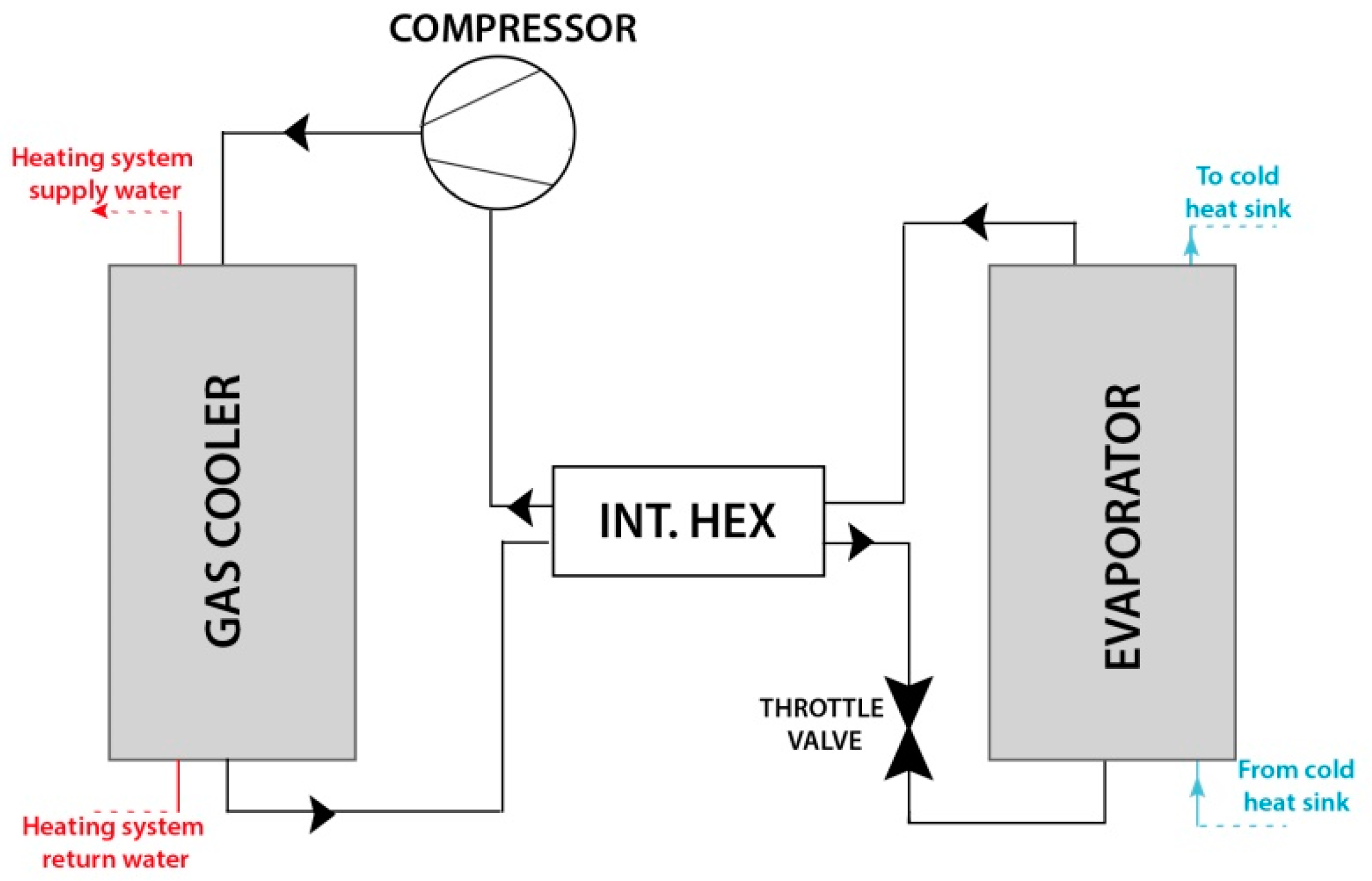




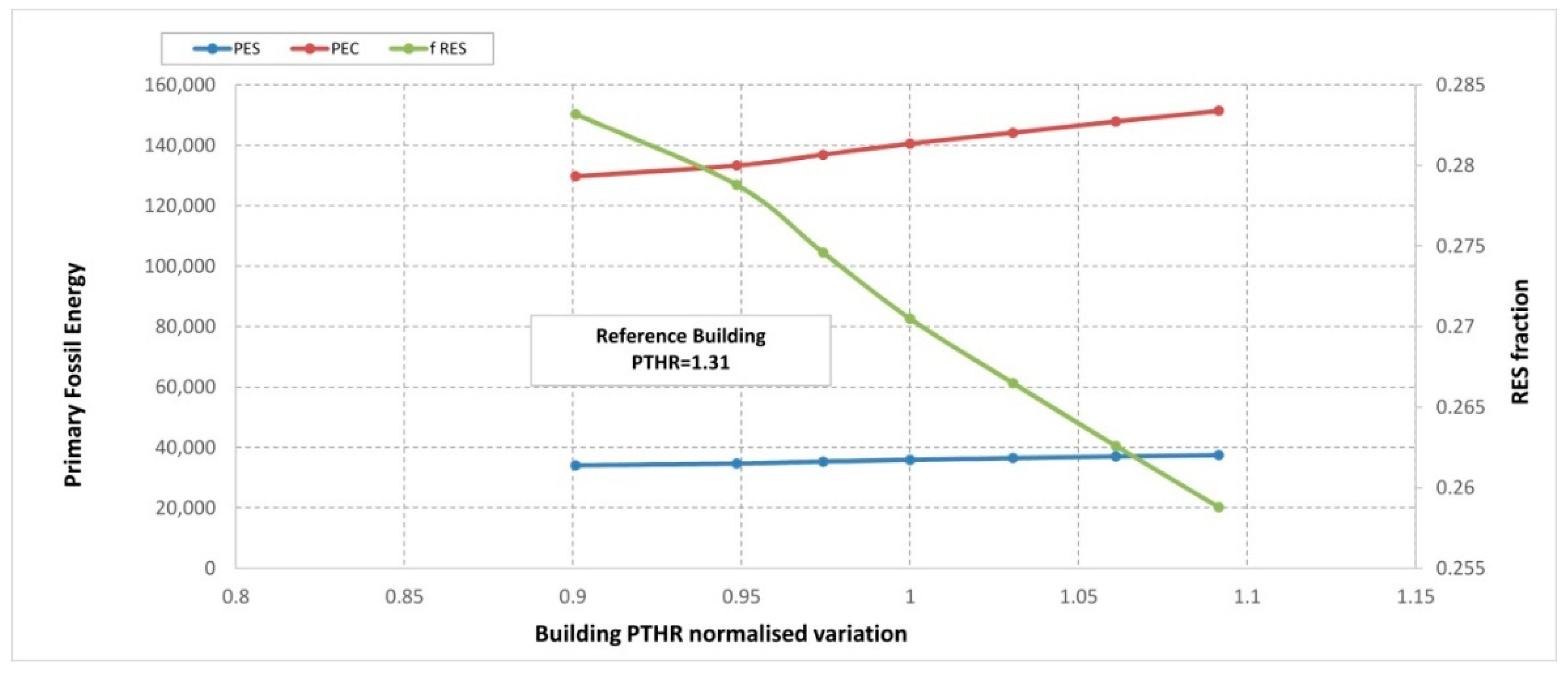
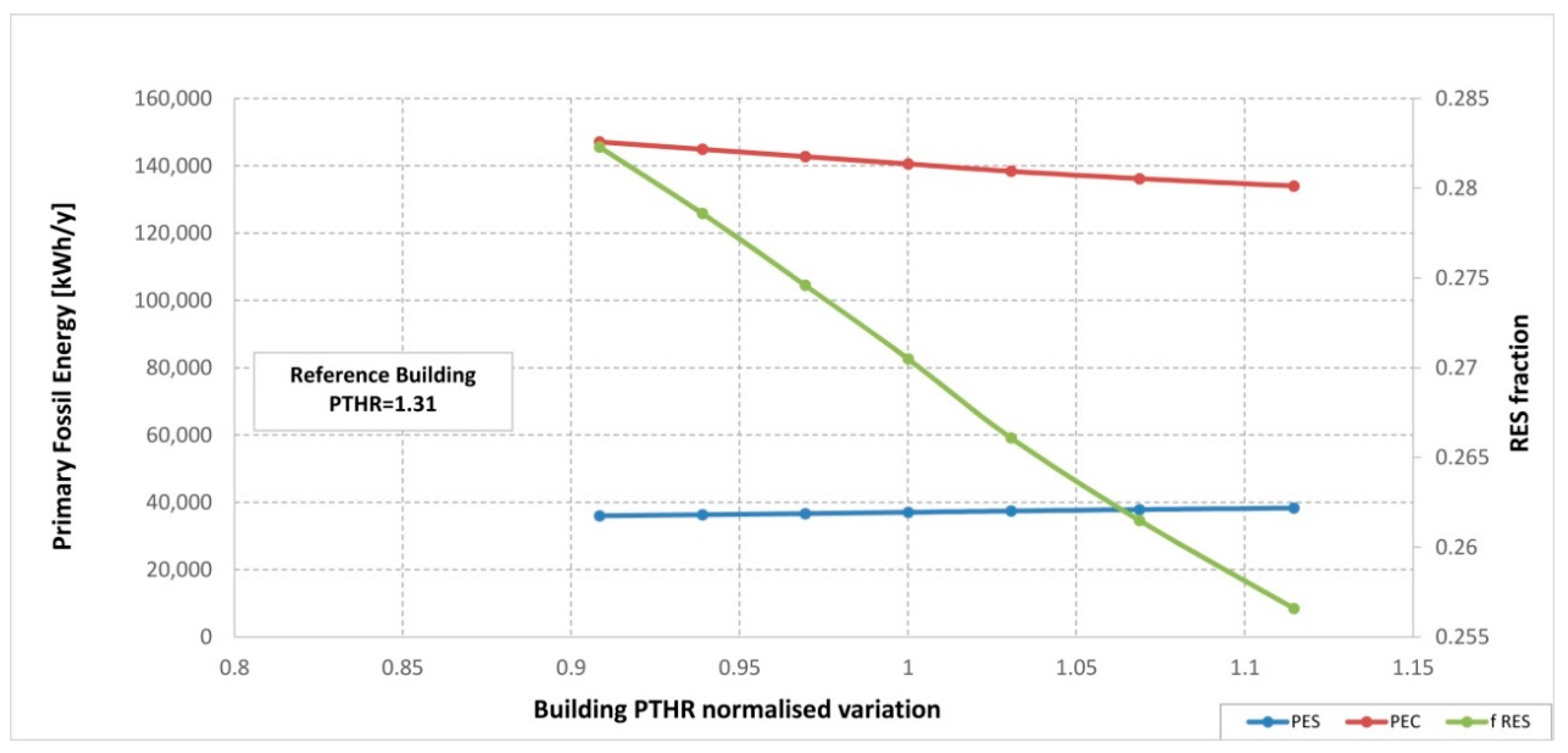
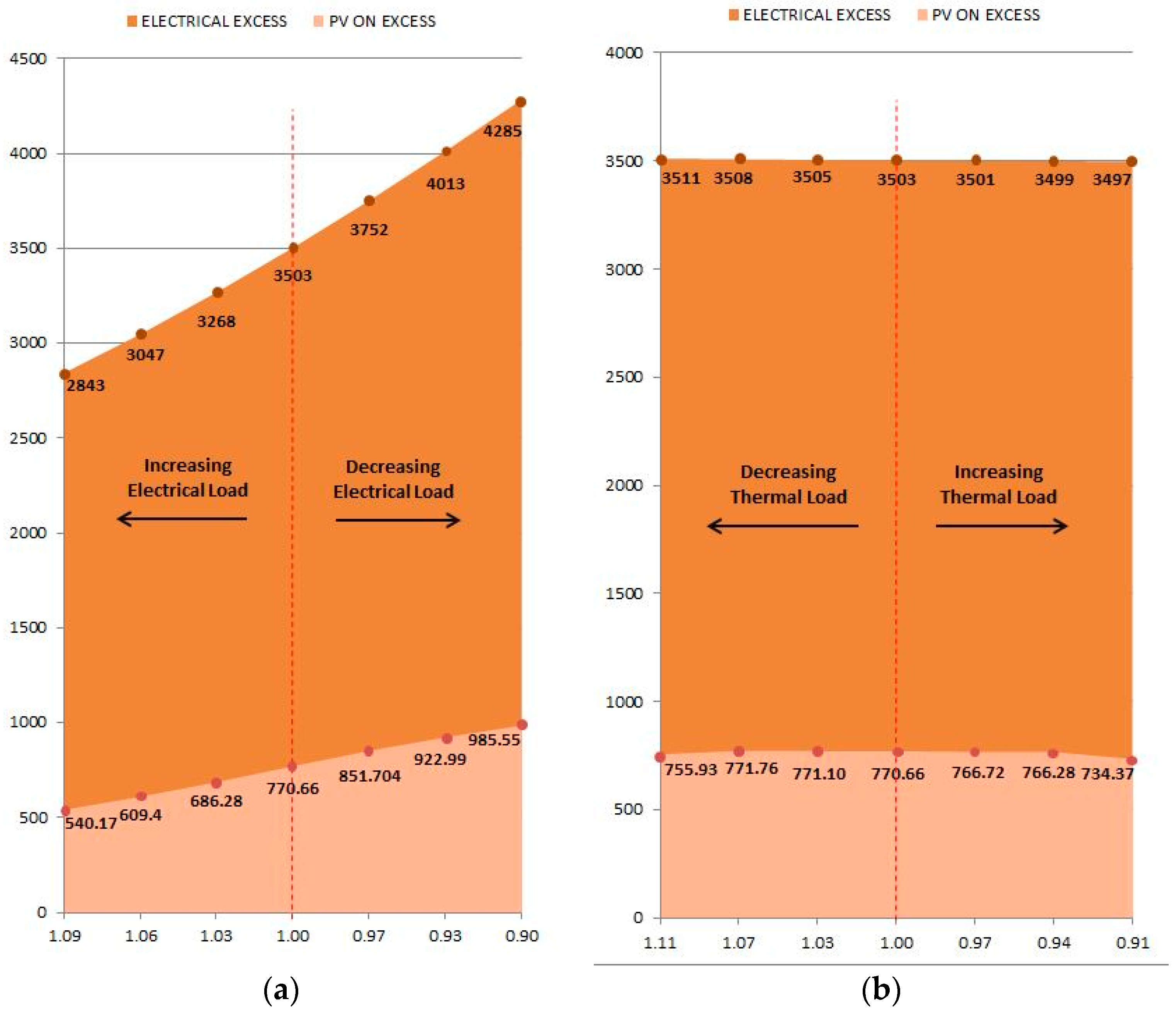
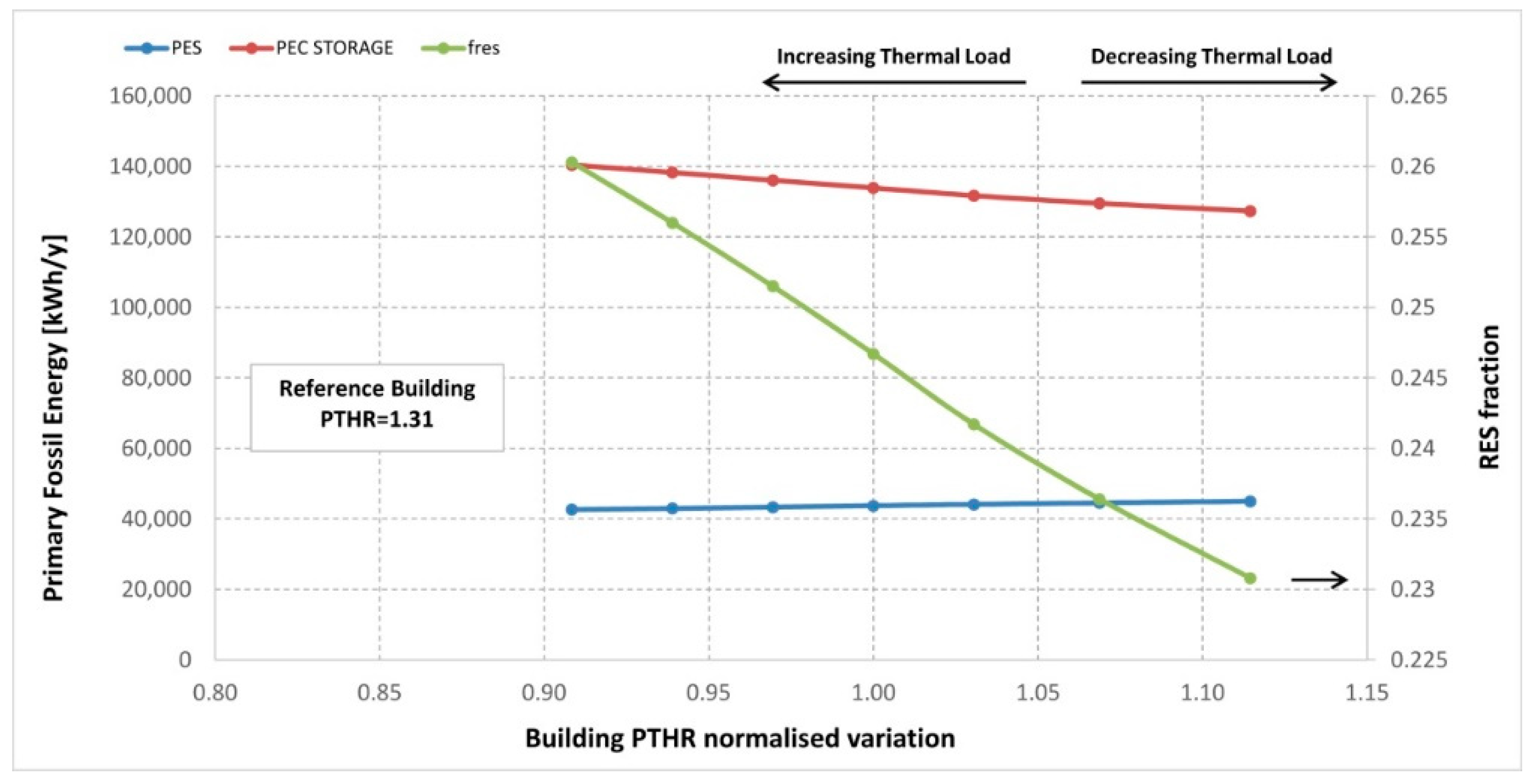
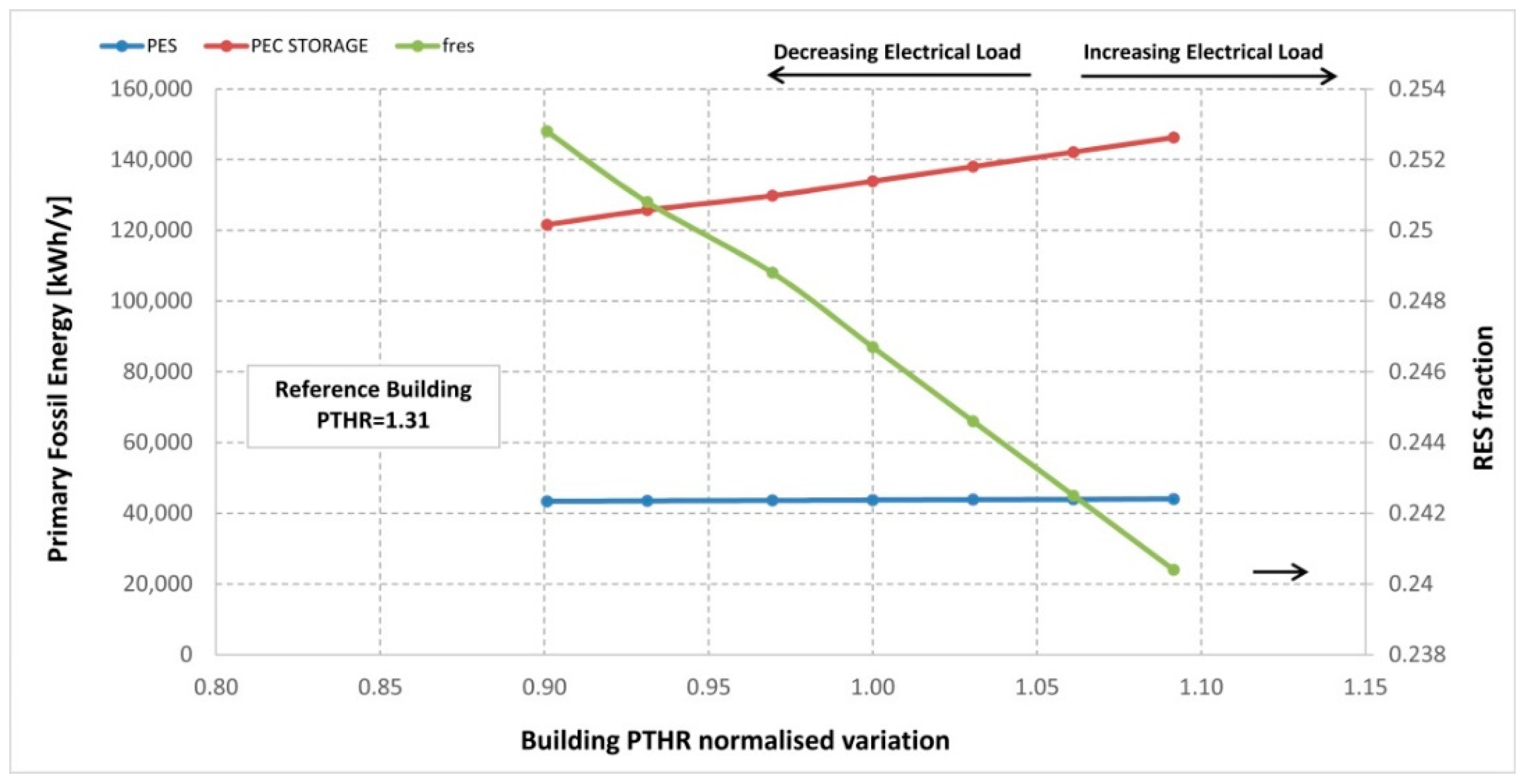

| Level | Spaces | Description | A [m²] | H [m] | Vn [m³] |
|---|---|---|---|---|---|
| Ground Floor | 1 | living room | 36.26 | 3.30 | 119.66 |
| Ground Floor | 2 | Bedroom 1 | 14.69 | 3.30 | 48.48 |
| Ground Floor | 3 | Bedroom 2 | 12.83 | 3.30 | 42.34 |
| Ground Floor | 4 | Bedroom 3 | 11.13 | 3.30 | 36.73 |
| Ground Floor | 5 | WC 1 | 4.14 | 3.30 | 13.66 |
| Ground Floor | 6 | Kitchen | 9.53 | 3.30 | 31.45 |
| Ground Floor | Total | 88.58 | 292.31 | ||
| Basement | 7 | Hall | 41.72 | 2.50 | 104.30 |
| Basement | 8 | Garage | 24.08 | 2.50 | 60.20 |
| Basement | 9 | guest room 4 | 13.65 | 2.50 | 34.13 |
| Basement | 10 | WC 2 | 8.30 | 2.50 | 20.75 |
| Basement | Total | 87.75 | 219.37 | ||
| Dwellings’ total | 176.33 | 511.68 |
| Geometrical Data | Ground Floor | Basement |
|---|---|---|
| External surface area (S)—m2 | 238.63 | 193.33 |
| Gross volume heated (V)—m3 | 369.86 | 288.05 |
| ratio of form to volume (S/V)—m2/m3 | 0.65 | 0.67 |
| Net heated surface—m2 | 88.58 | 87.75 |
| Net volume heated—m3 | 292.31 | 219.37 |
| Component | CO2 Parameter | Water Parameter | ||
|---|---|---|---|---|
| Gas cooler | T = 134.2 [°C] | P = 15 [MPa] | 55 °C Inlet | 65 °C Outlet |
| Internal heat exchanger | T = 33.67 [°C] T = 28.67 [°C] | P = 15 [MPa] P = 7 [MPa] | - | - |
| Evaporator | T = 28.67 [°C] | P = 7 [MPa] | 40 °C Inlet | 35 °C Outlet |
| Compressor | T = 51 [°C] | P = 7 [MPa] P = 15 [MPa] | - | - |
| Diameter DN | Pipes D × S | Insulation D (mm) | Insulation (kg/m) |
|---|---|---|---|
| 32 | 42.4 × 2.6 | 110 | 4.56 |
| 40 | 48.3 × 2.6 | 110 | 5.08 |
| 50 | 60.3 × 2.9 | 125 | 6.30 |
| Energy Performance Indicators | Hybrid System | Traditional System |
|---|---|---|
| heating efficiency | 2.31 | 0.67 |
| DHW efficiency | 0.52 | 0.80 |
| RES fraction on electricity | 0.10 | - |
| renewable heat fraction | 0.42 | - |
| Performance Indicator | Hybrid System | Traditional System |
|---|---|---|
| PEC [kWh] | 140,583 | 177,647 |
| PES [kWh] | 37,060 | |
| fRES | 0.27 | - |
| System efficiency | 0.84 | 0.55 |
© 2019 by the authors. Licensee MDPI, Basel, Switzerland. This article is an open access article distributed under the terms and conditions of the Creative Commons Attribution (CC BY) license (http://creativecommons.org/licenses/by/4.0/).
Share and Cite
de Santoli, L.; Lo Basso, G.; Astiaso Garcia, D.; Piras, G.; Spiridigliozzi, G. Dynamic Simulation Model of Trans-Critical Carbon Dioxide Heat Pump Application for Boosting Low Temperature Distribution Networks in Dwellings. Energies 2019, 12, 484. https://doi.org/10.3390/en12030484
de Santoli L, Lo Basso G, Astiaso Garcia D, Piras G, Spiridigliozzi G. Dynamic Simulation Model of Trans-Critical Carbon Dioxide Heat Pump Application for Boosting Low Temperature Distribution Networks in Dwellings. Energies. 2019; 12(3):484. https://doi.org/10.3390/en12030484
Chicago/Turabian Stylede Santoli, Livio, Gianluigi Lo Basso, Davide Astiaso Garcia, Giuseppe Piras, and Giulia Spiridigliozzi. 2019. "Dynamic Simulation Model of Trans-Critical Carbon Dioxide Heat Pump Application for Boosting Low Temperature Distribution Networks in Dwellings" Energies 12, no. 3: 484. https://doi.org/10.3390/en12030484
APA Stylede Santoli, L., Lo Basso, G., Astiaso Garcia, D., Piras, G., & Spiridigliozzi, G. (2019). Dynamic Simulation Model of Trans-Critical Carbon Dioxide Heat Pump Application for Boosting Low Temperature Distribution Networks in Dwellings. Energies, 12(3), 484. https://doi.org/10.3390/en12030484







